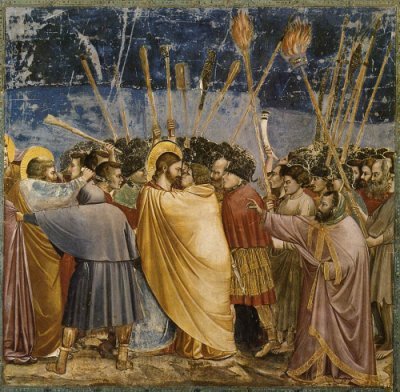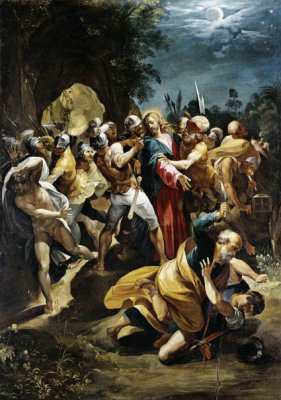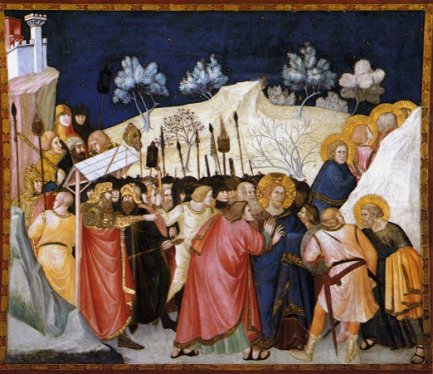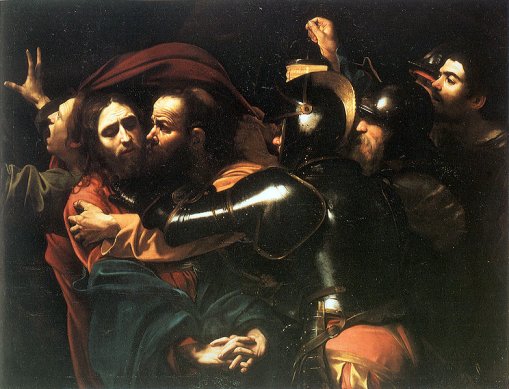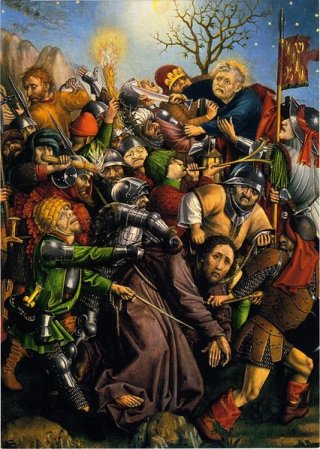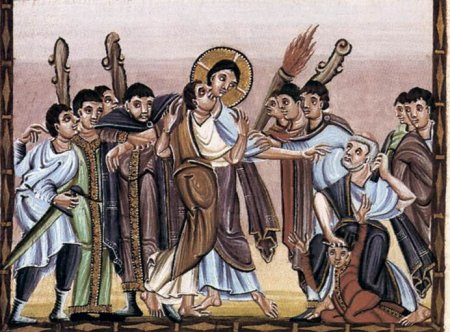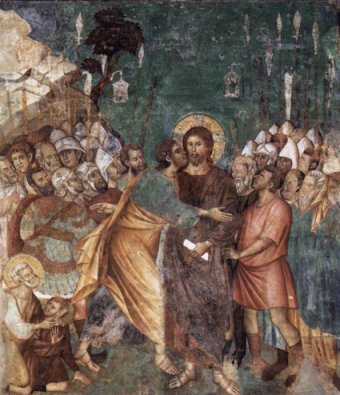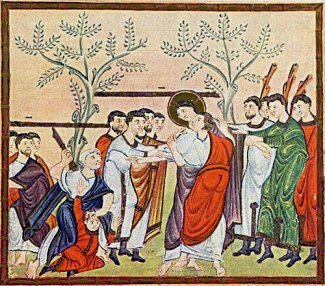|
The Passion of Christ |
|
|
The Arrest of Christ |
|
|
|
|
|
In many cycles, the arrest is regarded as the first event of Christ's Passion. The gospel writers generally agree on the sequence of events, but differ in detail, as we will explore. Many of the individual images and cycles we will look at go further than merely depicting narrative. They allow us to explore the age-old debate as to Christ's divinity on one hand and his humanity on the other. So the events the gospels have in common are: The enemies of Christ, led by Judas, arrive at Gethsemane. One of the disciples cuts off an ear of the high priest's servant. Christ is led away. Additional details: In both Mathew and John, the disciple is told to 'put up his sword'. In John, the servant is named as Malchus, and the disciple as Peter. In Luke, Christ heals the ear. In the synoptic gospels, Judas identifies Christ with a kiss. In John, Christ identifies himself. When he does so, the 'band of men' fall backwards. This is rarely depicted in art. In Mark, a 'certain young man' who has followed Jesus turns and flees, leaving his linen cloth in which he was clothed behind. This young man is often identified as Mark himself. The incident appears in this painting by Giuseppe Cesari; the young man is on the left. |
|
|
|
|
|
In Mathew and Mark, the disciples flee from the scene; in Luke and John, Christ is followed at a safe distance by Peter. In John, 'another disciple' follows as well. In John, Christ is bound before being led away. John's version - divinity over humanity? The synoptic gospels largely depict Christ as the passive victim of events - he is identified by the kiss and hauled away without offering resistance. John's gospel is subtly different. There is no mention of a kiss. Christ takes charge of the situation by identifying himself, and, as I've mentioned above, the band of men fall backwards when they hear this. This sculpture from St. Marien, Lubeck ( 1250-1350) is a rare depiction of the incident. |
|
|
|
|
|
Following Peter's attack on Malthus, Christ makes it clear that it is his decision to accept the arrest and that no resistance should be offered: 'the cup which my Father hath given me, shall I not drink it?' (Ch 18 v 11). The earliest images of the arrest stress the triumphant Christ. The earliest image of all is probably this one, on a sarcophagus at San Giovanni in Valle, Verona, dating from c. 400. The kiss of betrayal is on the far right. Unexpectedly, perhaps, the figure on the left is Christ. In most versions the stationary Christ is on the right, while Judas come towards him from the left, so that the action reflects the normal left to right reading of of an image. Here Christ appears to be advancing on Judas and putting out an arm. (Note though that Giotto also pictures Christ on the left. His Christ, too, is no passive victim. ) |
|
|
|
|
|
Paintings showing the patient, suffering Christ are particularly associated with the early years of the Franciscan order, though it should be stressed that these images were not simply there to arouse sympathy; for the Franciscans, the suffering of Christ was an essential part of his divine mission as Saviour of mankind. This picture by Pietro Lorenzetti comes from the Lower Church, San Francesco, Assisi. |
|
|
|
|
|
Christ here is shown as helpless, surrounded by his attackers, while the Disciples, apart from Peter, abandon him, scurrying away to the right. This emphasis informs most later art, and is dramatically shown in Caravaggio's version. Rather less moving, perhaps, is the somewhat bizarre, comic-book version by the Master of the Karlsruhe Passion, dating from around 1450. |
|
|
|
|
|
The attack on the servant As has been said, the cutting off of the ear is mentioned in all four gospels, though with differences: In Luke, Jesus heals the ear. In John, the servant and the disciple are named. In Picturing the Passion in Early Medieval Art, Anne Derbes shows how this incident gradually became less prominent in art from the eleventh century onwards. 'By deemphasising - nearly eradicating - the sole act of defence in Christs's behalf, the new image clearly reinforces the suggestion of Christ's vulnerability at the hands of his captors. But it also removes any reference to Christ's words to Peter, and thus his free acceptance of his fate'. (Incidentally, the Derbes book is essential reading on early images of passion events from this point in the story onwards.) Let's contrast two images: one from a 10th - 11th century manuscript, and one from an anonymous early thirteenth century fresco, this time from the upper church in Assisi. |
|
|
|
|
| In the Gospel book, Peter is prominent, and Christ is clearly rebuking him. In the Assisi fresco, the ear-cutting is tucked away in the bottom left, and Christ entirely ignores him. | |
|
Why did Peter have a sword? Three of the gospels describe Peter's weapon as a sword, but in most versions of the arrest he makes do with a knife. Why is this? Certainly in a crowded situation a knife would be easier to wield, and probably easier to paint convincingly. There might also be a feeling that swords are rather violent weapons for the disciples of Christ to carry around with them. And yet the disciples did have swords - two of them. Luke tells us about them: 'Then said he unto them, But now, he that hath a purse, let him take it, and likewise his scrip: and he that hath no sword, let him sell his garment, and buy one. For I say unto you, that this that is written must yet be accomplished in me, And he was reckoned among the transgressors: for the things concerning me have an end. And they said, Lord, behold, here are two swords. And he said unto them, It is enough. This passage has kept many a theologian busy. Some feel it is evidence that Jesus and the disciples were Zealots, Josephus's 'fourth sect', determined to expel the Romans by force, though just two swords would hardly be enough for that task. Another interpretation is that the swords were to be carried to justify Christ's arrest as a criminal, to fulfil the prophecy in Isaiah: 'and he was numbered with the transgressors; and he bare the sin of many, and made intercession for the transgressors. So to conclude, two images. The first, from the Codex Egberti dating from the tenth century, shows Peter wielding a heavy sword. And on the left, here it is, the actual sword, now in the Poznań Archdiocesan Museum in Poland. You may or may not be convinced about the authenticity of the relic, but it does rather match the one in the codex. |
|
|
|

|
